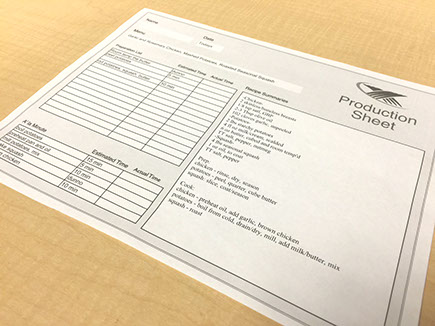
Plan Like a Chef
Why Are Production Sheets Important?
A chef, in their production planning, must be prepared, know what each recipe requires, and be able to prioritize. A production sheet facilitates this, and thus should be completed before starting any work on your meal service. Using this process will develop your ability to think about a recipe or dinner service as a production, rather than just following directions.
A production sheet is different from a recipe. Recipes tell you what ingredients you will need and what to do with them; a production sheet is a quick overview that tells you how to produce a dish that you already know how to make as efficiently as possible. Following production sheets allows chefs to work on multiple dishes at once: the chef organizes and prioritizes each step ahead of time, so that they can quickly adapt to different situations.
In a kitchen, a chef must think about all of the recipes and what will be needed for each. This requires planning and forethought. Here is how to plan your meal.


How to Create a Production Sheet
1. List the ingredients in each recipe.
2. Briefly summarize what you have to do with each ingredient. Each step shouldn’t be more than 1-3 words.
3. Break down the recipe into steps, and estimate the time needed for each step. (Whenever you do one of the steps, record the actual time required. This will help to better plan in the future.)
4. Put the list in order.
a. Group similar tasks together. For example, if you have to chop parsley for the main dish and chop tomatoes for the side dish, plan to do all of your chopping together.
b. The steps that take the most time or that are the most important should be done early in production, and simple steps should be near the end of the process. If you run short on time, you’ll only have to do the quick and easy steps, which should keep you from running too far behind.
5. Split the list into prep and a la minute sections.
6. Combine the recipe summary and timed list of tasks.